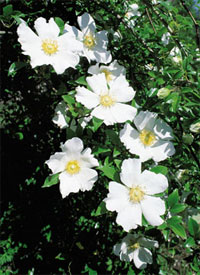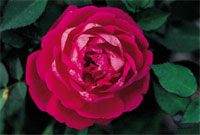Rose Cuttings – July, 2009

‘Old Blush’ spreads its lavish blooms around an aging
Texas farmstead. All photos courtesy of Mike Shoup.
Roses of Texas Independence
Many of the roses that we find so endearing in our modern gardens were also admired even as Texas was setting its own roots. In looking back, I’ve found catalogs, journals, almanacs and calendars that offer a glimpse of just how tenacious, yet useful, these roses were in the lives of our early pioneers. Here are a few tidbits from history:
Rose with 50 different flowers
Thomas Affleck, an early nurseryman in Central Texas and author of The Southern Rural Almanac and Plantation Garden Calendar, in 1845 discusses experiments with roses. “A rose with fifty varieties budded upon it, blooming at once” was recorded.

The Cherokee rose

‘Louis Philippe’
Living fence
He also spoke of the Cherokee rose. “The Cherokee rose is a strong growing evergreen, running rose with numerous strong thorns, grown readily from cuttings [sic] will form an impervious fence in four years, if well cared for. The long shoots interlace in such a manner, that no animal can force his way through a hedge of four feet in height.”
Two red roses of the Republic
Lorenzo de Zavala was a minister to France when Texas was a republic. In 1835, in Lynchburg, Texas, he and his wife, Emily, despite the unsettled political situation, made a fine garden that included the roses ‘Cramoisi Superieur’ and ‘Louis Philippe’. The roses had been presented to them as gifts when they left France in 1832. Both of these roses were used to line their porches. De Zavala later became vice president of the Texas Republic, and Emily, because of her love of flowers, remains the Texas first lady of roses.
Monthly rose
It was common to see roses planted beside the headstones of children. Diaries included statements about “monthly” roses on their graves. Monthly, daily and daisy rose were common names for ‘Old Blush’, which was certainly grown in the South by the 1800s. The Englishman William Bollart wrote that “one could plant ‘Old Blush’ in cemeteries because it was so drought hardy and heat tolerant, it naturalizes here.”
Rose rustling in the 1800s
William Falconer, an early Texas nurseryman, wrote that the “White Lady Banks” or “Bridal Rose” was a favorite for the cemetery. “Plants and slips are being continually stolen from the graveyard.”
Today these roses are living reminders of those hardy folk who, in the midst of a wilderness, still appreciated the beauty and sentiment of old roses.
About the author: Mike Shoup is the owner of the Antique Rose Emporium. Visit their Brenham and San Antonio display gardens for endless ideas on landscaping with roses. To order roses online, visit www.weAREroses.com.

